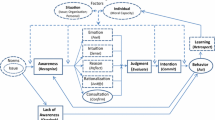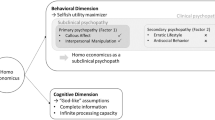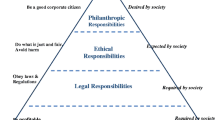Abstract
We present a comprehensive model that integrates virtues, values, character strengths and ethical decision making (EDM). We describe how a largely consequentialist ethical framework has dominated most EDM scholarship to date. We suggest that reintroducing a virtue ethical perspective to existing EDM theories can help to illustrate deficiencies in existing decision-making models, and suggest that character strengths and motivational values can serve as natural bridges that link a virtue framework to EDM in organizations. In conjunction with the more fully formulated extant research on situational determinants, we present and discuss our model that introduces a virtue based orientation to EDM.

Similar content being viewed by others
Notes
While the terms ethical and moral are often used interchangeably (e.g., Jones 1991), we understand ethics to be a system of beliefs that allows individuals to make decisions about difficult issues in order to determine what is right and wrong, while morality, more broadly construed, may encompass and support a particular ethical system, but may also include personal, cultural and societal norms and standards by which people judge the rightness or wrongness of behaviour (Hosmer 2008, p. 99). For example, at one point in time, slavery was considered morally acceptable behaviour. However, analyzing slavery through ethical frameworks such as consequentialism, deontology or virtue ethics, allows for a more methodological assessment of the rightness/wrongness of this behaviour. As well, something could be immoral individually yet moral organizationally as would be the case with alcohol where it may be immoral for some individuals to consume alcohol given religious beliefs, but still moral for organizations to serve alcohol at company events given company norms.
References
Agle, B. R., & Caldwell, C. B. (1999). Understanding research on values in business: A level of analysis framework. Business & Society, 38(3), 326–387.
Alzola, M. (2012). The possibility of virtue. Business Ethics Quarterly, 22(2), 377–404.
Aristotle. In H. Rackham (Ed.), Nicomachean ethics. Cambridge, MA: Harvard University Press. Accessed from http://www.perseus.tufts.edu/hopper/text?doc=Perseus:text:1999.01.0054. Accessed 21 Oct 2012.
Arjoon, S. (2000). Virtue theory as a dynamic theory of business. Journal of Business Ethics, 28(2), 159–178.
Arjoon, S. (2007). Ethical decision-making: A case for the triple font theory. Journal of Business Ethics, 71(4), 395–410.
Ashkanasy, N. M., Windsor, C. A., & Treviño, L. K. (2006). Bad apples in bad barrels revisited: Cognitive moral development, just world beliefs, rewards, and ethical decision-making. Business Ethics Quarterly, 16(4), 449.
Bandura, A. (1986). Social foundations of thought and action: A social cognitive theory. Englewood Cliffs, NJ: Prentice-Hall.
Bandura, A. (1991). Social cognitive theory of self-regulation. Organizational Behavior and Human Decision Processes, 50(2), 248–287.
Bardi, A., & Schwartz, S. H. (2003). Values and behavior: Strength and structure of relations. Personality and Social Psychology Bulletin, 29(10), 1207.
Beabout, G. R. (2012). Management as a domain-relative practice that requires and develops practical wisdom. Business Ethics Quarterly, 22(2), 405–432.
Beadle, R., & Moore, G. (2006). MacIntyre on virtue and organization. Organization Studies, 23(3), 323–340.
Bennis, W. G., & O’Toole, J. (2005). How business schools lost their way. Harvard Business Review, 83(5), 96–104.
Biggs, D. A., Schomberg, S. F., & Brown, J. (1997). Moral judgement development of freshmen and their precollege experiences. Research in Higher Education, 7(4), 329–339.
Brady, F. N., & Wheeler, G. E. (1996). An empirical study of ethical predispositions. Journal of Business Ethics, 15(9), 927–940.
Cameron, K. (2003). Organizational virtuousness and performance. In K. Cameron, J. Dutton, & R. Quinn (Eds.), Positive organizational scholarship: Foundations of a new discipline. San Francisco: Berrett-Koehler Publishers.
Cameron, K. (2006). Good or not bad: Standards and ethics in managing change. Academy of Management Learning and Education, 5(3), 317–323.
Cameron, K. (2011). Responsible leadership as virtuous leadership. Journal of Business Ethics, 98(1), 25–35.
Cameron, K. S., Dutton, J. E., & Quinn, R. E. (2003). Positive organizational scholarship: Foundations of a new discipline. San Francisco: Berrett-Koehler Publishers.
Caza, A., Barker, B. A., & Cameron, K. S. (2004). Ethics and ethos: The buffering and amplifying effects of ethical behavior and virtuousness. Journal of Business Ethics, 52(2), 169–178.
Comer, D. R., & Vega, G. (2008). Using the PET assessment instrument to help students identify factors that could impede moral behavior. Journal of Business Ethics, 77(2), 129–145.
Copleston, F. (1962). A history of philosophy, Vol. I: Greece and Rome. New York: Image Books, Doubleday.
Crilly, D., Schneider, S. C., & Zollo, M. (2008). Psychological antecedents to socially responsible behavior. European Management Review, 5(3), 175–190.
Crossan, M., Mazutis, D., Seijts, G., & Gandz, J. (2013). Developing leadership character in business programs. Academy of Management Learning and Education, 12(2).
Dimow, J. (2004). Resisting authority: A personal account of the Milgram obedience experiments. Jewish Currents.
Donaldson, T., & Dunfee, T. W. (1994). Toward a unified conception of business ethics: Integrative social contracts theory. Academy of Management Review, 19(2), 252–284.
Dutton, J. E., Worline, M. C., Frost, P. J., & Lilius, J. (2006). Explaining compassion organizing. Administrative Science Quarterly, 51(1), 59–96.
Egri, C. P., & Herman, S. (2000). Leadership in the North American environmental sector: Values, leadership styles, and contexts of environmental leaders and their organizations. Academy of Management Journal, 43(4), 571–604.
Eisenhardt, K. M., & Zbaracki, M. J. (1992). Strategic decision making. Strategic Management Journal, 13(S2), 17–37.
Ferrell, O. C., Fraedrich, J., & Ferrell, L. (2009). Business ethics: Ethical decision making and cases. Mason, OH: South Western Educational Publishing.
Fritzsche, D. J., & Becker, H. (1984). Linking management behavior to ethical philosophy—An empirical investigation. Academy of Management Journal, 27, 166–175.
Fritzsche, D. J., & Oz, E. (2007). Personal values’ influence on the ethical dimension of decision making. Journal of Business Ethics, 75(4), 335–343.
Gandz, J., Crossan, M., Seijts, G., & Stephenson, C. (2010). Leadership on trial: A manifesto for leadership development. London, ON: Ivey Publishing.
Ghoshal, S. (2005). Bad management theories are destroying good management practices. Academy of Management Learning and Education, 4(1), 75–91.
Graafland, J. J. (2009). Do markets crowd out virtues? An Aristotelian framework. Journal of Business Ethics, 91(1), 1–19.
Groves, K., Vance, C., & Paik, Y. (2008). Linking linear/nonlinear thinking style balance and managerial ethical decision-making. Journal of Business Ethics, 80(2), 305–325.
Hartman, E. M. (2006). Can we teach character? An Aristotelian answer. The Academy of Management Learning and Education, 5(1), 68–81.
Hill, A., & Stewart, I. (1999). Character education in business schools: Pedagogical strategies. Teaching Business Ethics, 3(2), 179–193.
Hitlin, S., & Piliavin, J. A. (2004). Values: Reviving a dormant concept. Annual Review of Sociology, 30, 359–393.
Homiak, M. (2007). Moral character. In Stanford encyclopedia of philosophy. Metaphysics Research Lab. Accessed from http://plato.stanford.edu/entries/moral-character/. Accessed 17 July 2010.
Hosmer, L. R. T. (2008). The ethics of management (6th ed.). New York: McGraw Hill/Irwin.
Hunt, S. D., & Vitell, S. A. (1986). A general theory of marketing ethics. Journal of Macromarketing, 8(2), 5–16.
Hursthouse, R. (2007). Virtue ethics. In Stanford encyclopedia of philosophy. Metaphysics Research Lab. Accessed from http://plato.stanford.edu/entries/ethics-virtue/. Accessed 18 July 2010.
Illies, J. J., & Reiter-Palmon, R. (2008). Responding destructively in leadership situations: The role of personal values and problem construction. Journal of Business Ethics, 82(1), 251–272.
Jones, T. M. (1991). Ethical decision making by individuals in organizations: An issue-contingent model. Academy of Management Review, 16(2), 366–395.
Jones, T. M., & Ryan, L. V. (1997). The link between ethical judgment and action in organizations: A moral approbation approach. Organization Science, 8(6), 663–680.
Kish-Gephart, J. J., Harrison, D. A., & Treviño, L. K. (2010). Bad apples, bad cases, and bad barrels: Meta-analytic evidence about sources of unethical decisions at work. Journal of Applied Psychology, 95(1), 1–31.
Krishnan, V. R. (2008). Impact of MBA education on students’ values: Two longitudinal studies. Journal of Business Ethics, 83(2), 233–246.
Locke, E. A. (1991). The motivation sequence, the motivation hub, and the motivation core. Organizational Behavior and Human Decision Processes, 50(2), 288–299.
Loe, T. W., Ferrell, L., & Mansfield, P. (2000). A review of empirical studies assessing ethical decision making in business. Journal of Business Ethics, 25(3), 185–204.
Luthans, F. (2002). The need for and meaning of positive organizational behavior. Journal of Organizational Behavior, 23, 695–706.
MacIntyre, A. (1991). Three rival versions of moral enquiry: Encyclopaedia, genealogy, and tradition. Notre Dame, IN: University of Notre Dame Press.
Manz, C. C., Anand, V., Joshi, M., & Manz, K. P. (2008). Emerging paradoxes in executive leadership: A theoretical interpretation of the tensions between corruption and virtuous values. The Leadership Quarterly, 19, 385–392.
Marx, R. D. (1982). Relapse prevention for managerial training: A model for maintenance of behavior change. Academy of Management Review, 7(3), 433–441.
May, D. R., Chan, A. Y. L., Hodges, T. D., & Avolio, B. J. (2003). Developing the moral component of authentic leadership. Organizational Dynamics, 32(3), 247–260.
Mintz, S. M. (1996). Aristotelian virtue and business ethics education. Journal of Business Ethics, 15(8), 827–838.
Nyberg, D. (2007). The morality of everyday activities: Not the right, but the good thing to do. Journal of Business Ethics, 81(3), 587–598.
O’Fallon, M. J., & Butterfield, K. D. (2005). A review of the empirical ethical decision-making literature: 1996–2003. Journal of Business Ethics, 59(4), 375–413.
Paine, L. S. (2003). Value shift: Why companies must merge social and financial imperatives to achieve superior performance. New York: McGraw-Hill.
Peterson, C., & Seligman, M. E. P. (2004). Character strengths and virtues: A handbook and classification. New York: Oxford University Press.
Rest, J. R. (1986). Moral development: Advances in research and theory. New York: Praeger Publishers.
Rokeach, M. J. (1973). The nature of human values. New York: The Free Press.
Sadler-Smith, E. (2012). Before virtue: Biology, brain, behaviour, and the “moral sense”. Business Ethics Quarterly, 22(2), 351–376.
Schmidt, C. D., McAdams, C. R., & Foster, V. (2009). Promoting the moral reasoning of undergraduate business students through a deliberate psychological education-based classroom intervention. Journal of Moral Education, 38(3), 315–334.
Schwartz, S. (1996). Value priorities and behavior: Applying a theory of integrated value systems. In C. Seligman, J. M. Olson, & M. P. Zanna (Eds.), The Ontario symposium: Vol. 8. The psychology of values (pp. 1–24). Hillsdale, NJ: Lawrence Erlbaum.
Seligman, M., & Csikszentmihalyi, M. (2000). Positive psychology. American Psychologist, 55(1), 5–14.
Smith, P. B., Peterson, M. F., & Thomas, D. C. (2008). The handbook of cross-cultural management research. Thousand Oaks, CA: Sage.
Solomon, R. C. (1992). Corporate roles, personal virtues: An Aristotelean approach to business ethics. Business Ethics Quarterly, 2(3), 317–339.
Sonenshein, S. (2007). The role of construction, intuition, and justification in responding to ethical issues at work: The sensemaking-intuition model. Academy of Management Review, 32(4), 1022–1040.
Stephens, B., & Smith, D. (2009). Accounting ethics and educational interventions: A combination of both the discrete and pervasive method. Journal of the Academy of Business Education, 10 (proceedings).
Tenbrunsel, A. E., & Smith-Crowe, K. (2008). Ethical decision making: Where we’ve been and where we’re going. Academy of Management Annals, 2, 545–607.
Treviño, L. K. (1986). Ethical decision making in organizations: A person–situation interactionist model. Academy of Management Review, 11(3), 601–617.
Treviño, L. K., Weaver, G. R., & Reynolds, S. J. (2006). Behavioral ethics in organizations: A review. Journal of Management, 32(6), 951–990.
Vera, D., & Rodriguez-Lopez, A. (2004). Strategic virtues: Humility as a source of competitive advantage. Organizational Dynamics, 33(4), 393–408.
Vogel, D. (2005). The market for virtue: The potential and limits of corporate social responsibility. Washington, DC: Brookings Institution Press.
Weaver, G. R. (2006). Virtue in organizations: Moral identity as a foundation for moral agency. Organization Studies, 27(3), 341–368.
Whetstone, J. T. (2001). How virtue fits within business ethics. Journal of Business Ethics, 33(2), 101–114.
Wright, T. A., & Goodstein, J. (2007). Character is not “dead” in management research: A review of individual character and organizational-level virtue. Journal of Management, 33(6), 928–958.
Yanow, D., & Tsoukas, H. (2009). What is reflection-in-action? A phenomenological account. Journal of Management Studies, 46, 1339–1364.
Zimbardo, P. G. (2008). The Lucifer effect: Understanding how good people turn evil. New York: Random House Inc.
Acknowledgments
We gratefully acknowledge the financial support of the Trudeau Foundation and the Ian O. Ihnatowycz Institute for Leadership at Richard Ivey School of Business, the insightful contributions of the practitioners in the “Leadership on Trial” study, as well as the insights provided by Jeffrey Gandz, Corey Mulvihill, Dusya Vera, editor Joan Fontrodona and the anonymous reviewers.
Author information
Authors and Affiliations
Corresponding author
Rights and permissions
About this article
Cite this article
Crossan, M., Mazutis, D. & Seijts, G. In Search of Virtue: The Role of Virtues, Values and Character Strengths in Ethical Decision Making. J Bus Ethics 113, 567–581 (2013). https://doi.org/10.1007/s10551-013-1680-8
Received:
Accepted:
Published:
Issue Date:
DOI: https://doi.org/10.1007/s10551-013-1680-8




